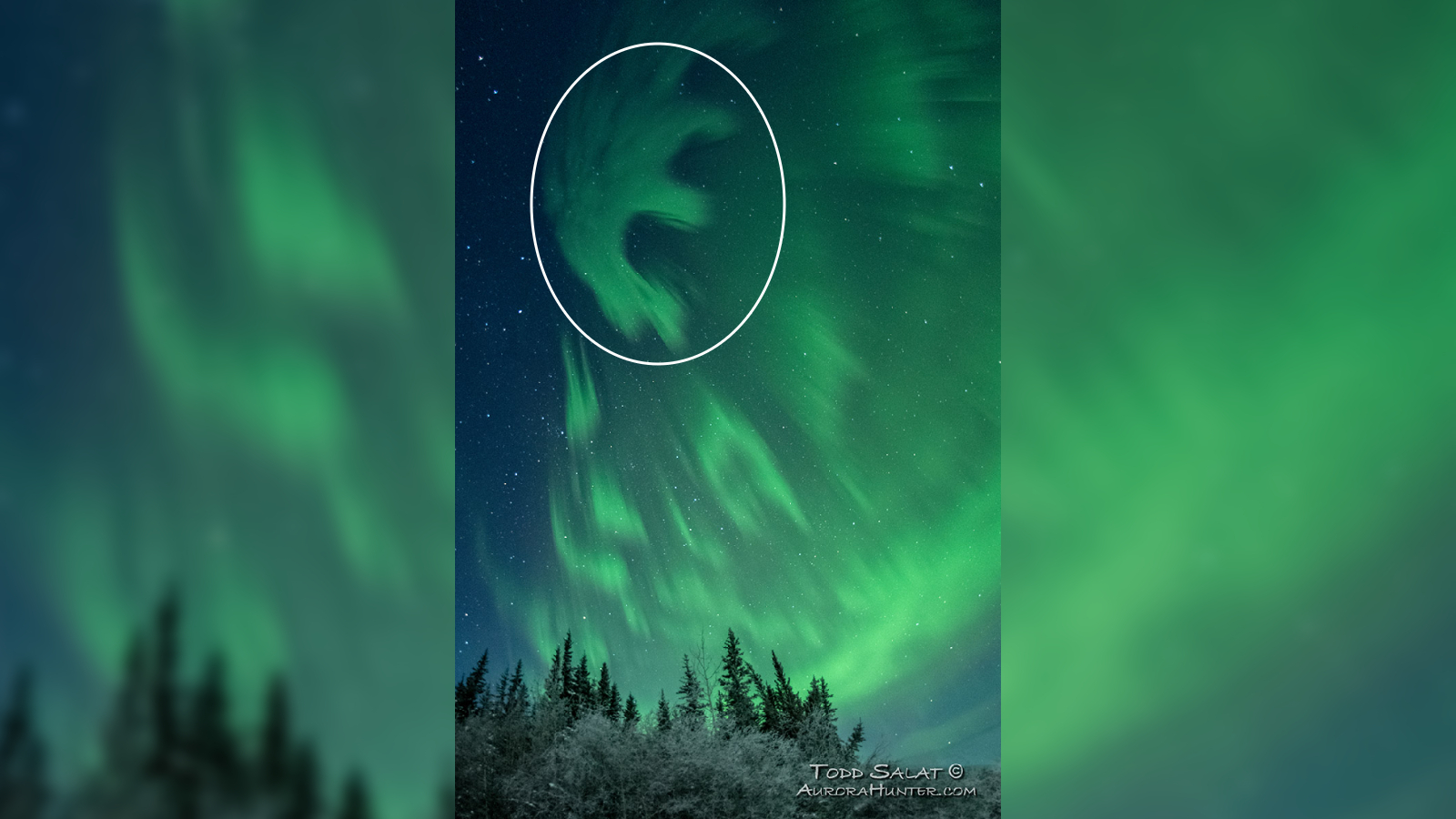Extremely rare, black 'anti-auroras' paint luminous 'letter E' above Alaska
A "bizarre" E-shaped aurora was recently photographed dancing in the sky above Alaska. The unusual light show was caused by rare black auroras, a.k.a. anti-auroras, which catapult charged particles from the sun back out of Earth's atmosphere and into space.

Extremely rare, black "anti-auroras" helped create a peculiar E-shaped swirl of green light recently photographed over Alaska, experts say.
Aurora hunter Todd Salat spotted the unusual aurora on Nov. 22 above an unspecified location in southcentral Alaska at around 4 a.m. local time (8 a.m. EST). The luminous letter appeared seemingly out of nowhere and lasted for a few minutes while cycling through several shapes, all of which contained strange dark patches not seen in most auroras.
"It came up from the northwest and I was like, 'whoa!' It looked like the letter E to me," Salat told Spaceweather.com. "Within just a few minutes it sailed overhead on its back and looked like some critter with its legs in the air."
The unusual aurora is the result of anti-auroras, a.k.a. black auroras. The strange phenomenon creates the rounded dark patches that look as if they have been bitten out from between the arms of the 'E' shape, Spaceweather.com reported.
As the name implies, anti-auroras are essentially the opposite of an aurora — they prevent gases from giving off energy in the form of light. The result is "dark rings, curls or blobs that punctuate the glowing colors," according to the European Space Agency (ESA).
Related: 32 stunning photos of auroras seen from space

Auroras are triggered when high-energy particles from the sun, predominantly electrons, bypass Earth's magnetic field, or magnetosphere, and superheat gas molecules in the upper atmosphere. The excited molecules release energy in the form of light, which collectively forms long smooth ribbons that twist in the sky. The color of the light varies depending on which element is being excited and where in the atmosphere it is located.
Sign up for the Live Science daily newsletter now
Get the world’s most fascinating discoveries delivered straight to your inbox.
The swirling light shows normally only occur sparsely near the poles where Earth's magnetic field is weakest. But they are particularly prominent and widespread now due to increased solar activity tied to solar maximum, the peak of the sun's roughly 11-year sunspot cycle.
However, anti-auroras interrupt the aurora-forming process by starving gases of charged particles.
"The black aurora isn't actually an aurora at all; it's a lack of auroral activity in a region where electrons are 'sucked' from the ionosphere," Göran Marklund, a plasma physicist at Sweden's Royal Institute of Technology in Stockholm, previously told ESA.

Anti-auroras were first identified in the late 1990s. But in 2001, scientists loosely figured out how they worked when ESA's four Cluster satellites passed through space above a black aurora sighting. This revealed small vertical cells in the upper atmosphere, known as positively charged electric potential structures, where electrons were being repelled back into space.
The mechanism behind these cells remained elusive for well over a decade, until a 2015 study utilizing more than a decade of Cluster mission data showed that these structures form when auroras deplete plasma, creating "ionospheric cavities," in the upper atmosphere while the magnetosphere shifts from the strain caused by solar storms. However, the conditions have to be just right for anti-auroras to appear.
Anti-auroras can occur in the Northern Lights and the Southern Lights and typically only last for around 10 or 20 minutes. Aurora activity is expected to remain high over the next few years so there is a decent chance we could see more examples of these dark patches dancing among them.

Harry is a U.K.-based senior staff writer at Live Science. He studied marine biology at the University of Exeter before training to become a journalist. He covers a wide range of topics including space exploration, planetary science, space weather, climate change, animal behavior and paleontology. His recent work on the solar maximum won "best space submission" at the 2024 Aerospace Media Awards and was shortlisted in the "top scoop" category at the NCTJ Awards for Excellence in 2023. He also writes Live Science's weekly Earth from space series.









